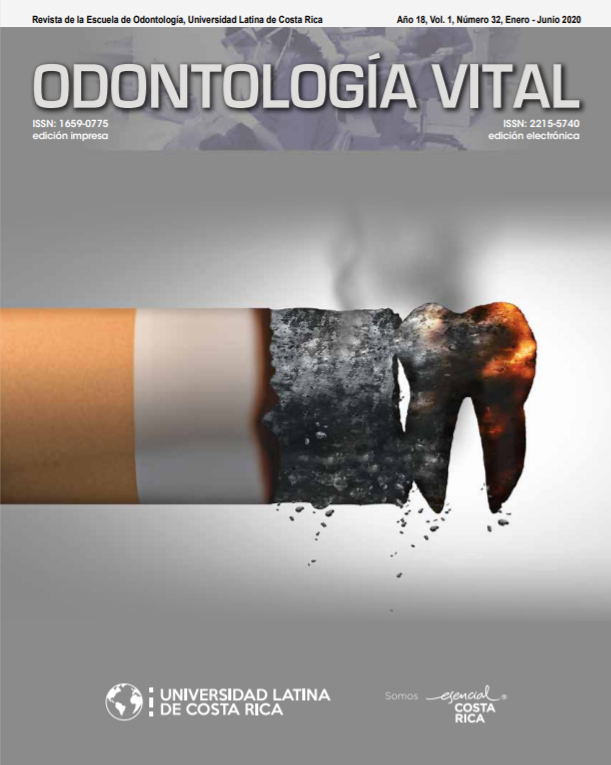Prevalence of dental agenesis in patients evaluated in orthodontics, Santiago de Chile
DOI:
https://doi.org/10.59334/ROV.v1i32.380Keywords:
Prevalence, anodontia, dental radiography, panoramic radiograph, tooth abnormalities, dental agenesis, hypodontia, orthodonticsAbstract
Dental agenesis is a frequent anomaly detected in a dental examination.
Objective: To determine the prevalence of agenesis in the current Chilean population, compare according to sex, affected tooth, skeletal class, and record microdontia of permanent upper lateral incisors.
Materials and methods: In this cross-sectional descriptive study, the number of dental agenesis present in 278 panoramic radiographs of a total of 9207 patients who entered orthodontic treatment during 2017 in a private clinical center in Santiago de Chile was recorded.
Results: A prevalence of agenesis of 3.02% was obtained, finding a higher frequency in lower second premolars, followed by upper lateral incisors. Females presented a higher amount of cases in comparison to males.
Conclusion: The second premolars are the teeth with the highest prevalence of agenesis. The association of this alteration with some specific skeletal class was not evidenced. More studies are suggested to describe it´s prevalence in the third molars, because according to the evolutionary theory this tooth might eventually disappear
Downloads
References
Acharya, PN, Jones SP, Moles D, Daljit G, Hunt NP. (2010). A cephalometric study to investigate the skeletal relationships in patients with increasing severity of hypodontia. The Angle Orthodontist. 80(4):699-706. https://doi.org/10.2319/072309-411.1
Baccetti, D. (1998). A controlled study of associated dental anomalies. The Angle Orthondontics. 68 (3): 267‐273.
Baum, BJ, Cohen MM. (1971). Agenesis and tooth size in the permanent dentition. Angle Orthod. 41: 100–102.
Bolaños, MV., Menéndez, M, Bolaños, MJ. (2000). Descripción de las características cefalométricas de los pacientes maloclusivos con agenesias dentarias y comparación respecto a valores normativos. Rev Esp Ortod. 30: 31-43.
Bozga, A., Stanciu, RP., M‐nuc, D., (2014). A study of prevalence and distribution of tooth agenesis. Journal of Medicine and Life. 7(4):551-554.
Celikoglu, M., Kazanci, F., Miloglu, O., Oztek, O., Kamak, H., Ceylan, I. (2010). Frequency and characteristics of tooth agenesis among an orthodontic patient population. med oral patol oral cir buccal. 15: 797-801. https://doi.org/10.4317/medoral.15.e797
Chappuzeau, E., Cortés, D.. (2008). Anomalías de la dentición en desarrollo: Agenesias y supernumerarios. Revista Dental de Chile. 99 (2): 3-8.
Díaz-Pérez, R., Echaverry-Navarrete, R. (2009). Agenesia en dentición permanente. Revista salud pública. 11(6): 961-969. https://doi.org/10.1590/S0124-00642009000600012
Feregrino-Vejar, L., Castillo-Carmona, I., Gutiérrez-Rojo, JF., Robles-Romero, DM. (2016). Frecuencia de agenesias dentarias en dentición permanente de pacientes que asisten a la clínica de ortodoncia de la Universidad Autónoma de Nayarit-México. Rev. Inv. Inf. Salud. 11: 27. https://doi.org/10.52428/20756208.v11i27.524
Garn, SM., Lewis, AB., Vicinus, JH. (1963). Third molar polymorphism and its significance to dental genetics. J Dent Res. 42:1344-63. https://doi.org/10.1177/00220345630420061001
Graber. LW., Varnasdall, RL., Vig, KW. (2012). Ortodoncia Principios y técnicas actuales. 5ed. España: Elsevier.
Gracco, A., Zanatta, S., Forin, Valvecchi, F., Bignotti, D., Perri, A., Baciliero, F.. (2017). Prevalence of dental agenesis in a sample of italian orthodontic patients: An epidemiological study. Progress in Orthodontics. 18: 33. https://doi.org/10.1186/s40510-017-0186-9
Mattheeuws, N., Dermaut, L.. Martens, G. (2004). Has hypodontia increased in Caucasians during the 20th century? A meta‐analysis. Eur J Orthod. 26 (1): 99‐103. https://doi.org/10.1093/ejo/26.1.99
Medina, AC., Del Pozo, R. (2013). Asociación entre agenesia dental y maloclusión en pacientes pediátricos. Revista de Odontopediatría Latinamericana. 3(2). https://doi.org/10.47990/alop.v3i2.43
Mossey, PA., (1999). The heritability of malocclusion: part 2. The influence of genetics in malocclusion. Br J Orthod. 26: 195–203. https://doi.org/10.1093/ortho/26.3.195
Pineda, P., Fuentes, R., Sanhueza, A. (2011). Prevalencia de agenesia dental en niños con dentición mixta de las clínicas odontológicas docente asistencial de la Universidad de la Frontera. Int. J. Morphol. 29(4):1087-1092. https://doi.org/10.4067/S0717-95022011000400002
Polder, BJ., Van’t Hof MA., Van der Linden, FP., Kuijpers-Jagtman, AM. (2004). A meta-analysis of the prevalence of dental agenesis of permanent teeth. Community Dent Oral Epidemiol. 32(3):217-26. https://doi.org/10.1111/j.1600-0528.2004.00158.x
Proffit, W., Fields, H., Sarver, D.. (2014). Contemporary Orthodontics. 5ed. United States: Elsevier Health Sciences.
Rakhshan, V., (2013). Meta-analysis and systemic review of factors biasing the observed prevalence of congenitally missing teeth in permanent dentition excluding third molars. Prog Orthod. 14:33. https://doi.org/10.1186/2196-1042-14-33
Tallón-Walton, V., Nieminen, P., Arte, S., Carvalho-Lobato, P., UstrellTorrent, JM., Manzanares-Céspedes, MC. (2010). An epidemiological study of dental agenesis in a primary health area in Spain: Estimated prevalence and associated factors. Med Oral Patol Oral Cir Bucal. 1,15(4): 569-74. https://doi.org/10.4317/medoral.15.e569
Vellini, F., (2002). Ortodoncia diagnóstico y planificación clínica. 1ed. Brasil: Artes Médicas Latinoamérica.
Yordanova, G., (2015). Tooth agenesis - the problem and its solving in our practice, prevalence and relation with other deformities. J of IMAB. 21(3):859-863. https://doi.org/10.5272/jimab.2015213.859
Zhang, J., Liu, HC., Lyu, X., Shen, GH., Deng, XX., Li, WR., Zhang, XX., Feng, HL., (2025). Prevalence of tooth agenesis in adolescent Chinese populations with or without orthodontics. Chin J Dent Res. 18(1):59-65.
Downloads
Published
Issue
Section
License
Copyright (c) 2020 Karim Yagnam Díaz, Isidora Rozas Escobar, Natasha Abdala Torres, Víctor Román Monsalve, Claudia Tapia Soler

This work is licensed under a Creative Commons Attribution 4.0 International License.
Authors who publish with Odontología Vital agree to the following terms:
- Authors retain the copyright and grant Universidad Latina de Costa Rica the right of first publication, with the work simultaneously licensed under a Creative Commons Attribution 4.0 International license (CC BY 4.0) that allows others to share the work with an acknowledgement of the work's authorship and initial publication in this journal.
- Authors are able to enter into separate, additional contractual arrangements for the non-exclusive distribution of the Odontología Vital's published version of the work (e.g., post it to an institutional repository or publish it in a book), with an acknowledgement of its initial publication.
- Authors are permitted and encouraged to post their work online (e.g., in institutional repositories or on their website) prior to and during the submission process, as it can lead to productive exchanges, as well as earlier and greater citation of published work.







